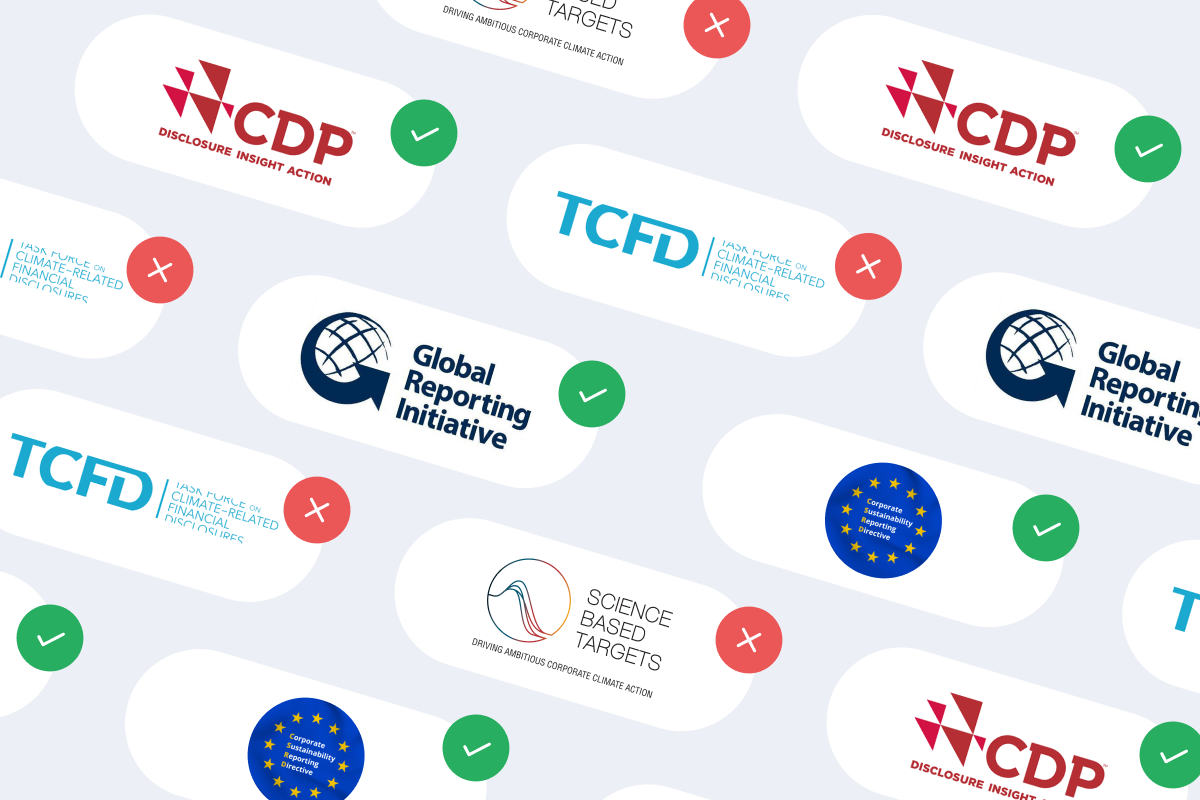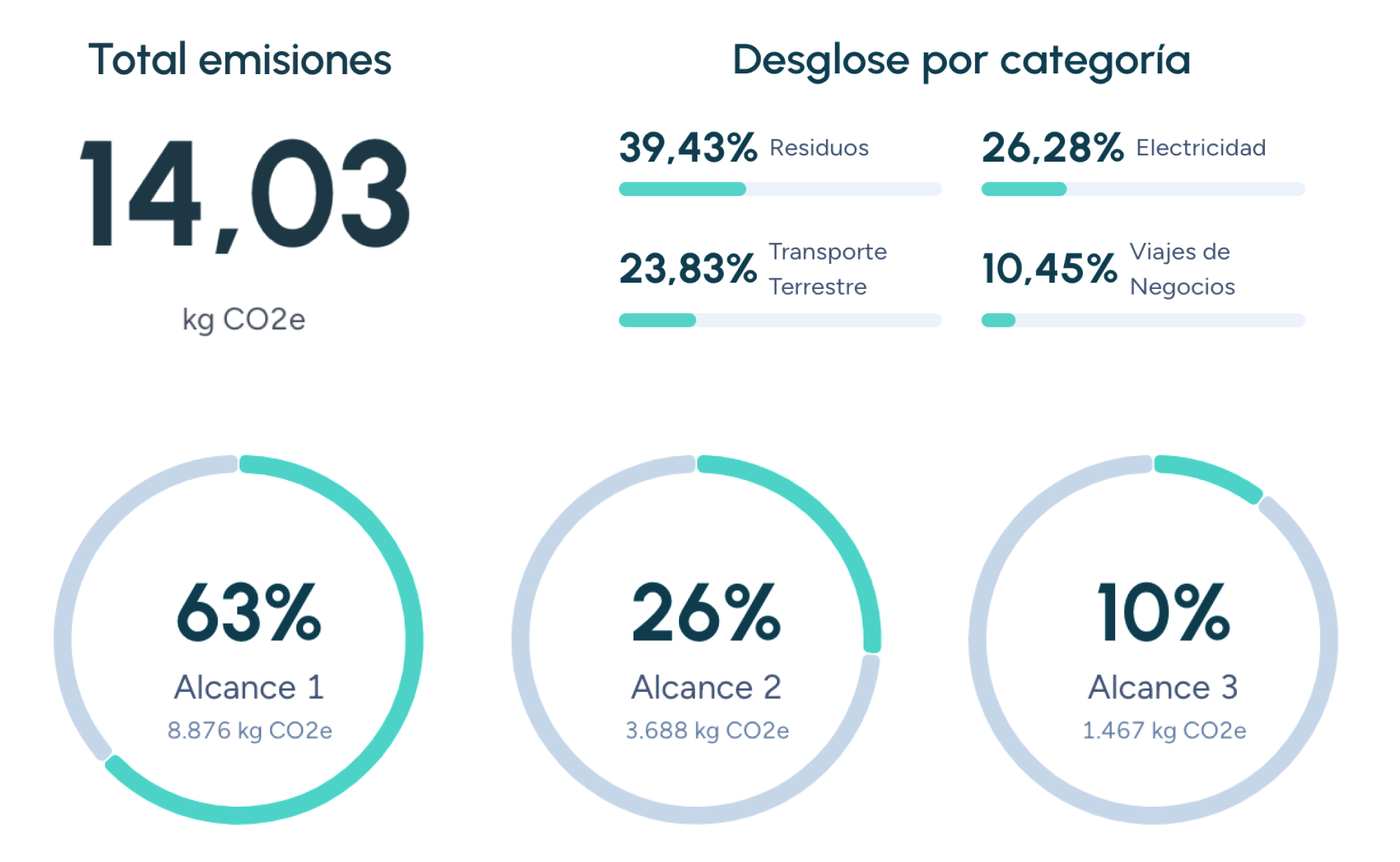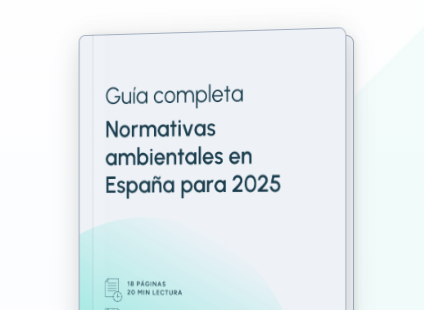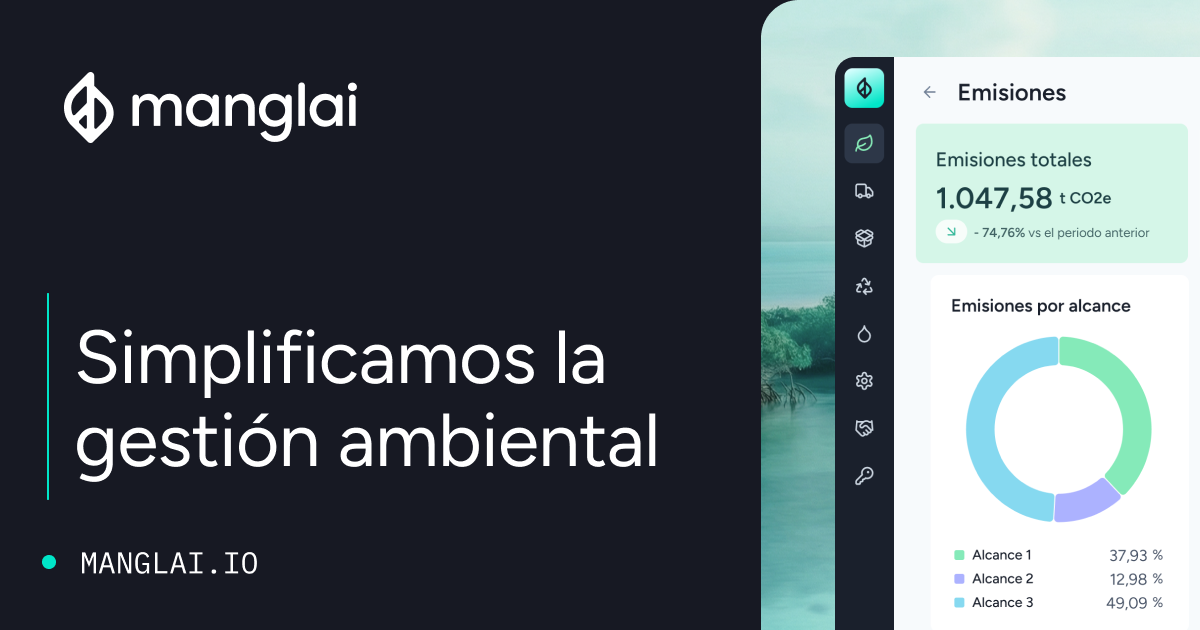Back to the blog
Practical guides
7 Best Software Tools to Measure Carbon Footprint
Jaume Fontal
CPTO & Co-Founder
Measuring the carbon footprint has become a requirement for companies seeking to comply with European sustainability standards and move toward genuine decarbonization.
Regulations such as the CSRD Directive, the EU Taxonomy Regulation, and the GHG Protocol demand transparent and traceable reporting of both direct and indirect emissions (Scopes 1, 2, and 3).
However, the challenge lies not only in collecting data but in doing so through a platform that ensures methodological rigor, ease of use, and integration with existing systems.
In this article, we help you identify the best software to calculate your carbon footprint, with Manglai leading the way, and explain which criteria to follow to make an informed decision.
What is the carbon footprint and why is it essential to measure it?
The carbon footprint represents the total amount of greenhouse gases (GHG) emitted, directly or indirectly, by an organization, activity, or product. It is measured in tons of CO₂ equivalent (tCO₂e) and helps identify the main emission hotspots to reduce them strategically.
According to the GHG Protocol, there are three levels or scopes of emissions:
- Scope 1: Direct emissions from owned or controlled operations (fuels, vehicles, machinery).
- Scope 2: Indirect emissions from purchased electricity, heat, or steam.
- Scope 3: Indirect emissions throughout the value chain (suppliers, logistics, travel, waste, etc.).
If you’d like to explore this third and most complex level, you can read our practical guide to Scope 3 of the GHG Protocol.
Accurately measuring your carbon footprint not only ensures regulatory compliance but also strengthens brand reputation, supports sustainable decision-making, and opens access to green financing opportunities.
What are the main criteria for choosing the best carbon footprint software?
Selecting the right software can be the difference between a superficial estimate and a verifiable sustainability report. A robust tool should meet six essential criteria:
- Recognized methodology: Alignment with the GHG Protocol, ISO 14064, and European reporting frameworks (CSRD, PEF).
- Data quality and coverage: Updated databases adapted to various sectors and geographies.
- Automation: Ability to import energy use, mobility, or supplier data from ERP systems or Excel.
- Usability: An intuitive interface and visual dashboards that make results easy to interpret.
- Scalability: Flexibility to expand from a few operations to an organization-wide analysis.
- Total cost of ownership: Considering licenses, technical support, and implementation time.
Which is the best software to calculate the carbon footprint?
Choosing the best carbon footprint software depends on your company’s needs, size, and climate maturity. Some solutions are designed for large corporations with dedicated sustainability teams, while others, such as Manglai, offer a practical and accessible approach for organizations seeking fast, verifiable results.
Below, we analyze the leading tools on the market and explain why Manglai stands out as the most balanced option for companies that value accuracy, efficiency, and compliance.
1. Manglai: Fast, rigorous, and ready-to-communicate measurement
Manglai leads the Spanish market as a platform that combines technical precision with ease of use to calculate the carbon footprint comprehensively.
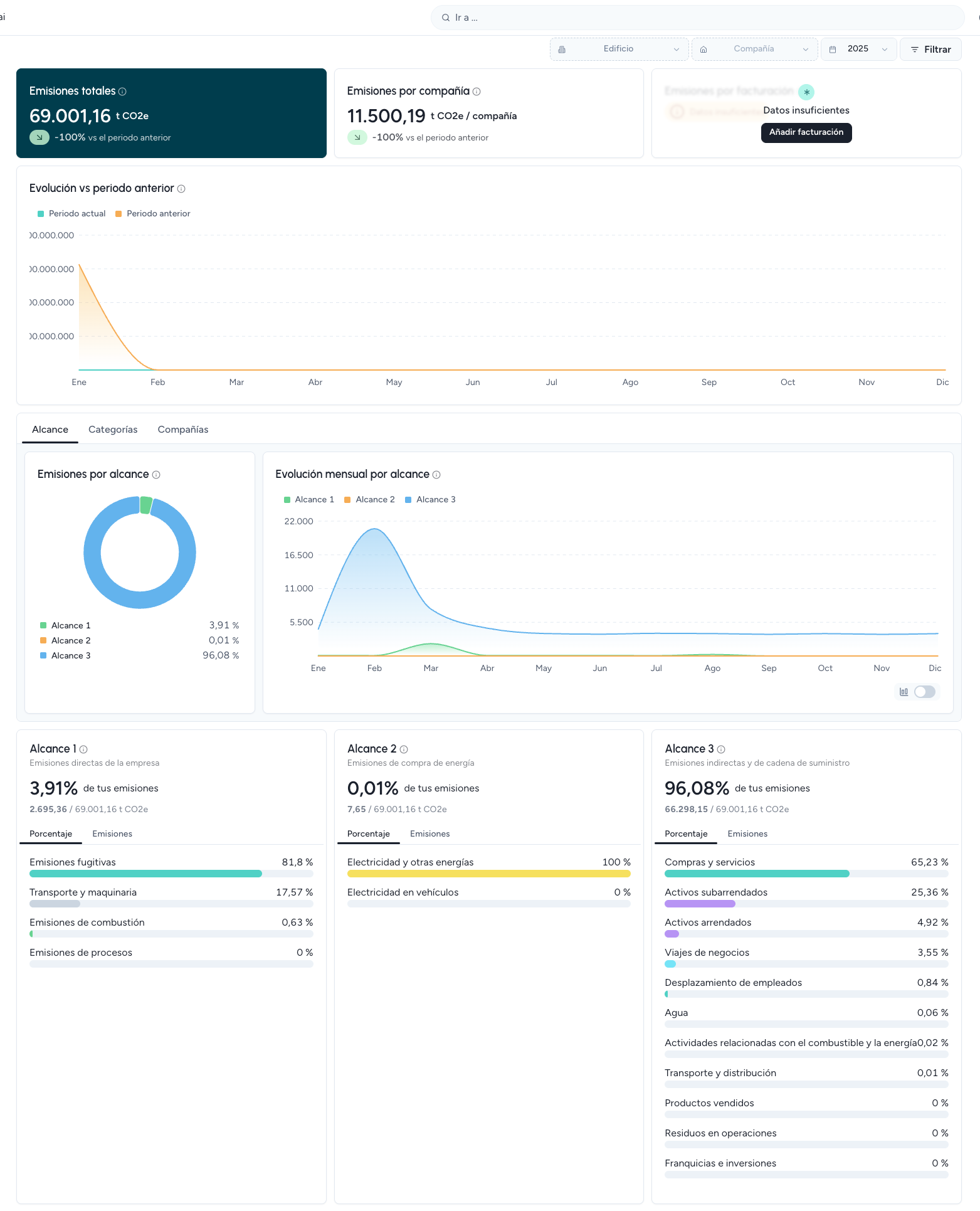
Its main advantages include:
- Guided workflow: The tool walks users through each step of the process, minimizing errors and omissions.
- Verified databases: It uses emission factors aligned with international sources such as DEFRA, IPCC, and Ecoinvent.
- Results visualization: Dashboards and charts that make it easy to present outcomes to management and stakeholders.
- Structured reporting: Automatic generation of reports ready to be included in sustainability disclosures or CSRD reporting.

Manglai also offers specific features to communicate decarbonization progress transparently, minimizing the risk of greenwashing. You can learn how to do this in our article: How to Communicate Your Decarbonization Strategy.
Ultimately, Manglai is ideal for companies that need to calculate their full carbon footprint (Scopes 1, 2, and 3) without relying on external consultancies or complex processes.
2. SAP Sustainability Footprint Management
Designed for companies already using the SAP ecosystem, this tool integrates large-scale data on energy consumption, materials, and processes. It is powerful but requires a significant investment and advanced technical knowledge.
3. Sphera Product Sustainability (GaBi)
A comprehensive Life Cycle Assessment (LCA) suite aimed at large industrial corporations. It offers strong scientific rigor and extensive databases, though its complexity makes it less accessible for SMEs.
4. One Click LCA
Popular in the construction and manufacturing sectors, this tool simplifies carbon footprint and environmental impact calculations through templates aligned with the European PEF standard.
It’s ideal for companies seeking to obtain Environmental Product Declarations (EPDs).
5. Ecochain
Designed for industrial SMEs, Ecochain combines ease of use with a global view of emissions by process or production site.
It’s an intermediate option between highly technical platforms and lightweight solutions.
6. CarbonCloud
Specialized in the food and FMCG sectors, CarbonCloud provides accurate industry models and allows companies to compare the footprint of different ingredients or production processes.
7. Carbonfact
Built for the fashion industry, Carbonfact facilitates emissions calculations per garment or collection.
Its niche focus makes it ideal for brands aiming to enhance climate traceability across their textile supply chains.
How to Start Measuring Your Carbon Footprint
Measuring your carbon footprint may seem complex, but with a structured methodology, it’s a completely manageable process.
The goal isn’t just to obtain a number — it’s to understand where emissions come from, prioritize reduction actions, and communicate results with credibility.
Here are the key steps to start effectively:
- Define the purpose of the calculation: Identify why you want to measure your carbon footprint — whether for regulatory compliance (e.g., CSRD, GHG Protocol), internal reduction goals, or sustainability reporting. A clear purpose guides the data collection process and determines the level of detail required.
- Set the scope of emissions: Decide whether to include only direct emissions (Scopes 1 and 2) or also indirect ones from the value chain (Scope 3). Including Scope 3 is essential for a complete understanding of your climate impact.
- Collect activity data: Gather all relevant data on electricity, fuel, transportation, business travel, waste, logistics, and purchased goods or services. The more accurate the data, the more reliable the results.
- Use reliable emission factors: Rely on recognized sources such as the International Energy Agency (IEA), DEFRA, or the IPCC. Leading carbon accounting software like Manglai integrates these databases to ensure transparency and traceability.
- Calculate, analyze, and validate results: Once the data is compiled, the tool calculates total emissions in tons of CO₂e. Verify that the system boundaries match the chosen methodology and analyze which activities contribute the most to your footprint.
- Communicate results and define actions: Present your findings clearly and credibly, tailored to management, clients, or investors. Good software generates audit-ready reports and makes it easy to track progress over time.
Measuring your carbon footprint isn’t a one-time task — it’s a continuous improvement process that enables companies to reduce energy use, optimize supply chains, and move toward carbon neutrality.
Technology and Rigor: Advancing Toward Climate Neutrality
Carbon footprint calculation has become the cornerstone of every sustainability strategy. It’s not just about measuring — it’s about understanding, acting, and communicating with precision.
Choosing the right software ensures that data is reliable, comparable, and actionable for decision-making. Manglai stands out as the most complete solution for organizations that seek to combine methodological rigor with operational agility, fully aligned with both regulatory frameworks and the realities of sustainability teams.
If you’re ready to take the next step toward reliable measurement and transparent communication, request a demo of Manglai and discover how you can calculate your carbon footprint with confidence.
FAQs about Choosing the Best Carbon Footprint Software
What is the best software for calculating carbon footprint?
Manglai is the most balanced option for organizations seeking a practical and verifiable approach, while SAP or Sphera are better suited for large corporations with extensive technical teams.
Which standards should I follow to calculate my carbon footprint?
The main reference is the GHG Protocol, alongside ISO 14064-1 and ISO 14067, which define how to measure, report, and verify greenhouse gas emissions.
Can I calculate my carbon footprint without complete data?
Yes. Most software tools allow the use of generic or sector-average emission factors, as long as the sources are documented and replaced with real data later on.
Is it mandatory to include all three scopes (1, 2, and 3)?
No, but it’s highly recommended. Scopes 1 and 2 are basic for any organization, while Scope 3 often represents over 70% of total emissions and is crucial for CSRD or Science Based Targets reporting.
How long does it take to calculate the carbon footprint?
It depends on automation and data availability. With Manglai, the initial calculation can be completed in a few weeks — compared to months with more complex systems.
What are the advantages of using software instead of spreadsheets?
Software ensures traceability, data consistency, and easier updates of emission factors. It also produces auditable reports and minimizes manual errors.
How can I communicate results without falling into greenwashing?
The key is to support every figure with verifiable data and recognized methodologies. Transparent, data-driven reporting is the best safeguard against greenwashing.
Jaume Fontal
CPTO & Co-Founder
About the author
Jaume Fontal is a technology professional who currently serves as CPTO (Chief Product and Technology Officer) at Manglai, a company he co-founded in 2023. Before embarking on this project, he gained experience as Director of Technology and Product at Colvin and worked for over a decade at Softonic. At Manglai, he develops artificial intelligence-based solutions to help companies measure and reduce their carbon footprint.
Content
Companies that trust us

7 Best Sustainability Management Software Tools Compliant with the CSRD
We analyse the best software solutions to comply with the CSRD: traceability, ESG reporting and automation with Manglai leading the ranking.
10 December, 2025
8 Best Software Tools for Calculating Emissions Under the GLEC Framework
We compare the best tools to measure product and transport emissions under the GLEC Framework, with Manglai leading the ranking.
01 December, 2025
8 Best Software Tools for Service Carbon Footprint Management
We compare the leading tools for calculating the service carbon footprint:international options, pros and cons, with Manglai at the top.
24 November, 2025
Guiding businesses towards net-zero emissions through AI-driven solutions.
© 2025 Manglai. All rights reserved
Política de Privacidad